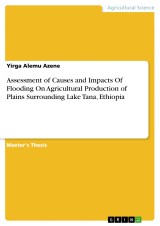Details

Assessment of Causes and Impacts Of Flooding On Agricultural Production of Plains Surrounding Lake Tana, Ethiopia
1. Auflage
|
CHF 42.00 |
|
| Verlag: | Grin Verlag |
| Format: | |
| Veröffentl.: | 26.11.2020 |
| ISBN/EAN: | 9783346304674 |
| Sprache: | englisch |
| Anzahl Seiten: | 165 |
Dieses eBook erhalten Sie ohne Kopierschutz.
Beschreibungen
Master's Thesis from the year 2007 in the subject Agrarian Studies, grade: Very Good, , course: Irrigation Engineering, language: English, abstract: This study is an attempt to identify the main causes and effect of flooding on agricultural production and the peoples living in the Lake Tana surroundings. Although floods are relatively common during the June to September rainy season in Ethiopia, the magnitude of the current flooding in 2006 is unprecedented. In year 2006 the country has experienced some of the heaviest and most intense rains on record; resulting in flash floods and/or the overflow of rivers, lakes and dams, where local residents have been advised to leave. The impact of the disaster in terms of lives, infrastructure, livelihoods, and basic coping mechanisms has yet to be assessed
The rainfall variability analysis of the Lake Tana (LT) basin in 2006 showed an on average 43% increase in wet season rainfall than the normal (mean). All rainfall gauging stations show an increase in rainfall in 2006. Similarly, the variability analysis of major rivers also showed that on average 35% increase in flood season streamflow of G/Abay, Gumara, Rib, Megech, and Koga. The trend of these rivers shows that maximum runoff for the year 2006 was higher than the mean of the long term maximum flood. Whereas Lake Tana maximum flood level of 2006 (1787.155masl) shows an increase of 16 cm only from the mean flood levels of previous records (1787 masl). The Pearson III method of the moment probability distribution is the best fit for Megech and Rib rivers. For Gumara river Pearson III probability weighted moment distribution better estimate flood quantiles with less standard error. It is also found that Gamma two probability weighted moment is the best fit for Lake Tana water surface level. In general, from rainfall and flood frequency analysis the 2006-year flooding may have a chance to occur once in six years in LTB. The 2006-year flood damage indicates that there is a high impact on agricultural production of Lake Tana surrounding plains. 107,647 peoples were actually affected by floods. At least 448, 910 quantal of food grain, 1230 domestic animals, 9634 chickens, and 1088 bee-hives were damaged by the 2006 flood. The impacts of flooding on socio-economic and environmental resource indicators were qualitatively assessed. Totally twenty-seven indicators were assessed.
The rainfall variability analysis of the Lake Tana (LT) basin in 2006 showed an on average 43% increase in wet season rainfall than the normal (mean). All rainfall gauging stations show an increase in rainfall in 2006. Similarly, the variability analysis of major rivers also showed that on average 35% increase in flood season streamflow of G/Abay, Gumara, Rib, Megech, and Koga. The trend of these rivers shows that maximum runoff for the year 2006 was higher than the mean of the long term maximum flood. Whereas Lake Tana maximum flood level of 2006 (1787.155masl) shows an increase of 16 cm only from the mean flood levels of previous records (1787 masl). The Pearson III method of the moment probability distribution is the best fit for Megech and Rib rivers. For Gumara river Pearson III probability weighted moment distribution better estimate flood quantiles with less standard error. It is also found that Gamma two probability weighted moment is the best fit for Lake Tana water surface level. In general, from rainfall and flood frequency analysis the 2006-year flooding may have a chance to occur once in six years in LTB. The 2006-year flood damage indicates that there is a high impact on agricultural production of Lake Tana surrounding plains. 107,647 peoples were actually affected by floods. At least 448, 910 quantal of food grain, 1230 domestic animals, 9634 chickens, and 1088 bee-hives were damaged by the 2006 flood. The impacts of flooding on socio-economic and environmental resource indicators were qualitatively assessed. Totally twenty-seven indicators were assessed.
Diese Produkte könnten Sie auch interessieren:

Agricultural Biodiversity and Biotechnology in Economic Development

von: Joseph Cooper, Leslie Lipper, David Zilberman

CHF 236.00

Policy Reforms and Agriculture Development in Central Asia

von: Sandjar Djalalov, Suresh Chandra Babu

CHF 236.00

Regulating Agricultural Biotechnology

von: Richard E. Just, Julian M. Alston, David Zilberman

CHF 236.00













